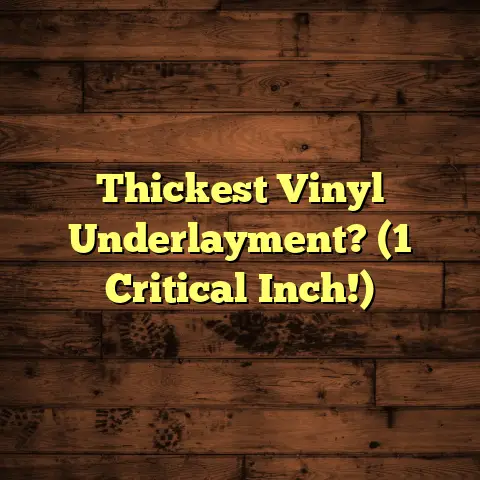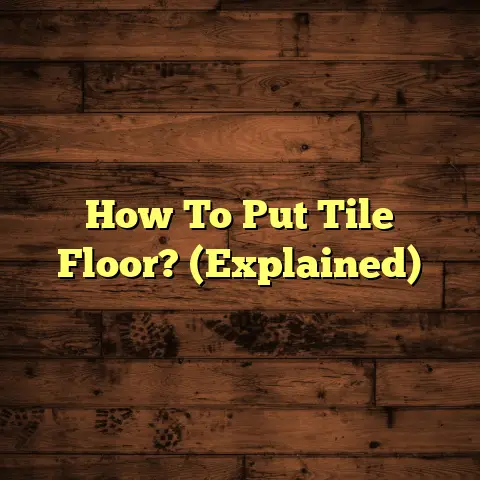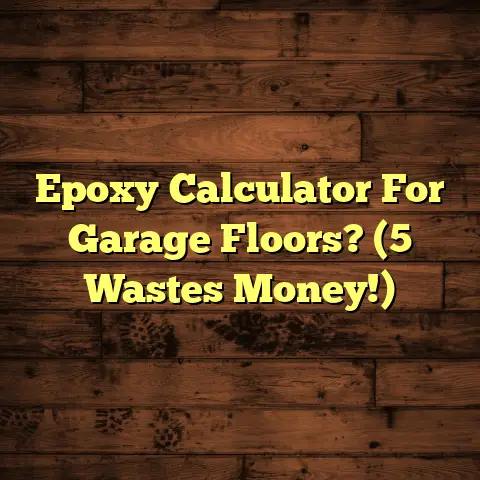What is Unsealed Wood Flooring? (6 Big Risks!)
As a flooring contractor with years of experience, I’ve seen it all – the good, the bad, and the downright ugly when it comes to flooring choices.
And let me tell you, few decisions are as impactful, both aesthetically and financially, as choosing the right type of wood flooring for your home.
Wood flooring brings warmth, character, and a touch
of elegance to any space.
It’s an investment that can
significantly enhance your property value and create a
welcoming atmosphere for you and your loved ones.
But, like any investment, it’s crucial to be well-informed before taking the plunge.
Today, I want to talk about a specific type of wood flooring that often gets overlooked: unsealed wood flooring.
While it possesses a certain rustic charm, it also comes with a unique set of risks that you absolutely need to be aware of before making a decision.
So, grab a cup of coffee, settle in, and let’s dive into the
world of unsealed wood flooring.
I’ll explain what it is,
the potential pitfalls, and whether it’s the right choice for you.
Section 1: Understanding Unsealed Wood Flooring
First things first, what exactly is unsealed wood flooring?
Simply put, it’s wood flooring that hasn’t been treated with a protective sealant or finish.
Think of it like this: sealed wood flooring has a raincoat, while unsealed wood flooring is out there braving the elements in its birthday suit.
The difference between sealed and unsealed wood comes down to the final layer applied to the wood.
Sealed wood flooring has a topcoat of polyurethane,
varnish, or another type of sealant.
This creates a barrier
that protects the wood from moisture, stains, and everyday wear.
Unsealed wood flooring, on the other hand, is left in its natural state, without any of these protective layers.
Manufacturing and Wood Types
The manufacturing process for unsealed wood flooring is similar to that of sealed flooring, up until the final finishing stage.
The wood is harvested, milled into planks, and then dried to reduce its moisture content.
Common wood types used for unsealed flooring include:
- Pine: A softwood known for its affordability and rustic appearance.
- Oak: A hardwood prized for its durability and classic grain patterns.
- Maple: A hardwood with a smooth, uniform grain and a lighter color.
- Reclaimed Wood: Wood salvaged from old buildings, barns, or other structures.
Natural Beauty and Unique Grain
One of the main draws of unsealed wood flooring is its natural beauty.
The absence of a sealant allows the wood’s natural grain patterns and textures to shine through, creating a warm and inviting atmosphere.
Each plank is unique, with its own variations in color, knots, and grain.
This can add a lot of character to a room, especially if you’re going for a rustic or farmhouse-style aesthetic.
Common Uses
Unsealed wood flooring is often used in:
- Farmhouses and Cottages: The rustic charm complements these styles.
- Lofts and Industrial Spaces: Adds warmth and character to modern spaces.
- Retail Spaces: Creates a unique and inviting atmosphere.
- Restaurants: Can add to a rustic or vintage theme.
However, I need to stress that while it looks great, it’s not always the most practical choice, especially in high-traffic areas or rooms prone to moisture.
And that brings us to the first big risk…
Section 2: Risk #1 – Moisture Damage
Alright, let’s talk about the elephant in the room: moisture.
Unsealed wood flooring is extremely susceptible to moisture damage.
Think of it like a sponge – it soaks up water like there’s no tomorrow.
Moisture Absorption
Without a protective sealant, unsealed wood readily absorbs moisture from the air, spills, and even your shoes after a rainy day.
This can lead to a whole host of problems, including:
- Warping: The wood planks can bend and twist out of shape.
- Buckling: The planks can lift up from the subfloor, creating an uneven surface.
- Cupping: The edges of the planks can rise up, creating a concave surface.
- Rotting: In severe cases, the wood can start to decay and rot.
Scenarios of Irreversible Damage
I’ve seen firsthand the devastating effects of moisture on unsealed wood flooring.
Here’s one example:
I had a client who installed unsealed pine flooring in their kitchen.
They loved the look, but they weren’t careful about cleaning up spills.
One day, a water pipe under the sink burst, flooding the kitchen.
By the time they discovered the leak, the wood flooring had already absorbed a significant amount of water.
The result? Warping, buckling, and extensive water damage.
The flooring had to be completely replaced, costing them thousands of dollars.
Another scenario I’ve seen is when homeowners install unsealed wood flooring in a basement without proper moisture control.
Basements are naturally damp environments, and the unsealed wood can quickly absorb moisture from the concrete slab, leading to similar problems.
Statistics on Moisture Damage
According to the Forest Products Laboratory, wood can expand and contract by as much as 5% due to changes in moisture content.
This may not sound like much, but it can be enough to cause significant damage to your flooring.
Another study by the National Wood Flooring Association (NWFA) found that moisture-related issues are one of the leading causes of flooring failures.
So, if you’re considering unsealed wood flooring, you need to be extremely vigilant about moisture control.
This means:
- Cleaning up spills immediately.
- Using a dehumidifier in damp environments.
- Ensuring proper ventilation in your home.
- Avoiding installation in areas prone to moisture, such as bathrooms and basements.
But even with the best precautions, moisture damage is still a significant risk.
And that leads us to the next problem…
Section 3: Risk #2 – Stains and Discoloration
Let’s face it: life happens. Spills happen. Dirt happens.
And when those things happen on unsealed wood flooring, they can leave a lasting mark – literally.
Proneness to Staining
Unsealed wood flooring is incredibly prone to staining.
Without a protective sealant, liquids can easily penetrate the wood fibers, leaving behind unsightly stains.
Common culprits include:
- Coffee and Tea: These can leave dark, persistent stains.
- Red Wine: A notorious stain offender.
- Pet Urine: Can cause discoloration and unpleasant odors.
- Dirt and Mud: Can grind into the wood, creating a dull, dirty appearance.
Difficulty in Cleaning
Cleaning unsealed wood flooring can be a real challenge.
Unlike sealed flooring, which can be easily wiped clean with a damp mop, unsealed wood requires special care.
You can’t use harsh chemicals or abrasive cleaners, as these can damage the wood.
Instead, you need to use gentle, pH-neutral cleaners specifically designed for wood.
Even with the right cleaners, removing stains can be difficult, if not impossible.
Anecdotes and Case Studies
I remember one client who installed unsealed oak flooring in their dining room.
They loved to entertain, but they weren’t always the most careful hosts.
One evening, a guest spilled a glass of red wine on the floor.
Despite their best efforts to clean it up, a stubborn red stain remained.
They tried everything – baking soda, vinegar, even professional stain removers.
But nothing worked.
The stain was there to stay, a constant reminder of that fateful evening.
Another client had unsealed pine flooring in their entryway.
Over time, the flooring became stained with dirt and mud from shoes.
The stains were so ingrained that they couldn’t be removed, no matter how hard they scrubbed.
The flooring looked dull, dirty, and worn, even though it was only a few years old.
The Bottom Line
The bottom line is that unsealed wood flooring is a magnet for stains.
If you’re not prepared to be extremely careful and diligent about cleaning, you’re likely to end up with a stained and discolored floor.
And that can significantly detract from the beauty and value of your home.
But stains aren’t the only thing you need to worry about.
There’s another, more insidious threat lurking in the shadows…
Section 4: Risk #3 – Pest Infestation
Creepy crawlies.
Wood-munching monsters.
Whatever you call them, pests can
wreak havoc on unsealed wood flooring.
Attracting Pests
Unsealed wood is particularly attractive to pests, especially termites and other wood-boring insects.
These pests are drawn to the wood’s natural cellulose content, which they use as a food source.
Without a protective sealant, the wood is essentially an open buffet for these critters.
Long-Term Implications
A pest infestation can have serious long-term implications for your flooring and your property.
Termites can tunnel through the wood, weakening its structure and causing extensive damage.
Over time, this can lead to:
- Sagging Floors: The floor can start to sag and become uneven.
- Weakened Support Beams: The underlying support beams can be compromised, leading to structural instability.
- Costly Repairs: Repairing termite damage can be expensive, often requiring the replacement of entire sections of flooring.
- Reduced Property Value: A termite infestation can significantly reduce the value of your home.
Statistics and Research
According to the National Pest Management Association (NPMA), termites cause billions of dollars in damage to homes each year in the United States.
A study by the University of California, Berkeley, found that termites can consume up to 1 pound of wood per day.
That may not sound like much, but over time, it can add up to significant damage.
Prevention is Key
Preventing pest infestations is crucial if you have unsealed wood flooring.
Here are some steps you can take:
- Regular Inspections: Have your home inspected for termites and other pests on a regular basis.
- Proper Ventilation: Ensure proper ventilation in your crawl space or basement to prevent moisture buildup, which can attract pests.
- Remove Wood Debris: Remove any wood debris or mulch from around the foundation of your home, as these can provide a food source for pests.
- Treat the Wood: Consider treating the wood with a borate-based wood preservative, which can help to deter pests.
But even with the best precautions, pest infestations can still occur.
And when they do, they can be a nightmare to deal with.
So, if you’re considering unsealed wood flooring, you need to be aware of the risk of pest infestation and take steps to protect your investment.
Now, let’s talk about another risk that can hit you where it hurts: your wallet.
Section 5: Risk #4 – Increased Maintenance Costs
Unsealed wood flooring might seem like a cost-effective option upfront, but don’t be fooled.
The long-term maintenance costs can quickly add up, making it a more expensive choice in the end.
Higher Maintenance Demands
Unsealed wood flooring requires significantly more maintenance than sealed flooring.
This is because it’s more susceptible to damage from moisture, stains, and wear.
You’ll need to:
- Clean More Frequently: You’ll need to clean the floor more often to remove dirt, spills, and other debris.
- Use Special Cleaners: You’ll need to use special cleaners specifically designed for wood, which can be more expensive than 일반 cleaners.
- Refinish More Often: You’ll need to refinish the floor more often to remove scratches, stains, and other imperfections.
- Repair Damage: You’ll need to repair any damage, such as warping, buckling, or pest infestations, as soon as it occurs.
Frequency of Cleaning and Refinishing
How often you’ll need to clean and refinish your unsealed wood flooring depends on several factors, including:
- Foot Traffic: High-traffic areas will require more frequent cleaning and refinishing.
- Lifestyle: Homes with pets or children will require more frequent cleaning.
- Climate: Humid climates will require more frequent cleaning and refinishing to prevent moisture damage.
In general, you can expect to clean unsealed wood flooring at least once a week, and refinish it every few years.
Cost Analysis
Let’s take a look at a cost analysis comparing the maintenance expenses for unsealed vs.
sealed wood flooring:
As you can see, the maintenance costs for unsealed wood flooring are significantly higher than those for sealed flooring.
Over time, these costs can add up to thousands of dollars.
The Bottom Line
The bottom line is that unsealed wood flooring is a high-maintenance option.
If you’re not prepared to invest the time and money required to maintain it properly, you’re better off choosing a sealed alternative.
And that brings us to the next risk: a shorter lifespan.
Section 6: Risk #5 – Limited Lifespan
Everything has a lifespan, and unsealed wood flooring is no exception.
Unfortunately, its lifespan tends to be shorter than that of sealed wood flooring.
Longevity Comparison
Sealed wood flooring can last for decades, even centuries, with proper care.
Unsealed wood flooring, on the other hand, typically lasts for a shorter period, often just a few years.
This is because it’s more susceptible to damage from moisture, stains, pests, and wear.
Factors Contributing to Wear and Tear
Several factors can contribute to the wear and tear of unsealed wood flooring, including:
- Foot Traffic: High foot traffic can wear down the wood’s surface, leading to scratches and dents.
- Environmental Conditions: Humid climates can cause the wood to warp and buckle.
- Sunlight: Exposure to direct sunlight can cause the wood to fade and discolor.
- Lack of Maintenance: Neglecting to clean and refinish the floor can accelerate its deterioration.
Expert Opinions and Studies
According to the NWFA, the average lifespan of unsealed wood flooring is 10-20 years, while the average lifespan of sealed wood flooring is 25-50 years.
A study by the Forest Products Laboratory found that unsealed wood flooring is more prone to wear and tear than sealed flooring, especially in high-traffic areas.
The Bottom Line
The bottom line is that unsealed wood flooring has a limited lifespan.
If you’re looking for a flooring option that will last for decades, you’re better off choosing a sealed alternative.
And that leads us to the final risk: resale value concerns.
Section 7: Risk #6 – Resale Value Concerns
When it comes time to sell your home, you want to make sure you’re getting the best possible price.
Unfortunately, unsealed wood flooring can be a red flag for potential buyers, potentially impacting your home’s resale value.
Impact on Resale Value
Unsealed wood flooring can negatively impact your home’s resale value for several reasons:
- Perception of High Maintenance: Buyers may perceive unsealed wood flooring as being high-maintenance, which can deter them from making an offer.
- Concerns About Damage: Buyers may be concerned about existing damage, such as stains, warping, or pest infestations.
- Modern Preferences: Many buyers prefer the look and durability of sealed wood flooring or other modern flooring options.
Challenges When Selling
You may face several challenges when trying to sell a property with unsealed wood floors:
- Lower Offers: Buyers may offer a lower price to compensate for the perceived risks and maintenance costs associated with unsealed wood flooring.
- Difficulty Attracting Buyers: Some buyers may simply refuse to consider a property with unsealed wood flooring.
- Need for Repairs or Replacement: You may need to invest in repairs or replacement to make the flooring more appealing to buyers.
Real Estate Expert Insights
According to real estate experts, flooring is one of the most important factors that buyers consider when evaluating a property.
Outdated or damaged flooring can significantly detract from a home’s appeal and reduce its market value.
“Flooring is one of the first things buyers notice when they walk into a home,” says Sarah Jones, a real estate agent with 10 years of experience.
“If the flooring is in poor condition, it can create a negative impression and make it harder to sell the property.”
The Bottom Line
The bottom line is that unsealed wood flooring can be a liability when it comes time to sell your home.
If you’re concerned about resale value, you’re better off choosing a sealed flooring option that is more appealing to buyers.
Conclusion
So, there you have it – the six big risks associated with unsealed wood flooring:
- Moisture Damage
- Stains and Discoloration
- Pest Infestation
- Increased Maintenance Costs
- Limited Lifespan
- Resale Value Concerns
As you can see, while unsealed wood flooring can add beauty and charm to a home, the potential risks can outweigh the benefits if not properly understood and managed.
Before making an investment, weigh your options carefully and consider the long-term implications of your flooring choices.
Call to Action
Now, I want to hear from you!
Have you had experience with unsealed wood flooring?
What are your thoughts on this type of flooring?
Do you have any questions or advice to share?
Leave a comment below and let’s start a conversation!
Remember, being informed is the key to making smart choices when investing in home improvements.





